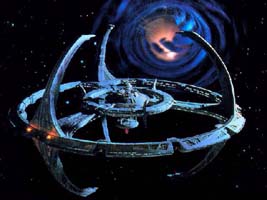
This page was last modified 18 August 2004 .
Lifters in vacuum & why they DO NOT work
Lifters, ionocrafts or any form of EHD thruster, may look mysterious at first glance due to the lack of moving parts. To make things worse and promote confusion, these interesting devices have also found their place on antigravity/free energy websites and have also been sold, at some science suppliers, as antigravity devices. The lift mechanism may be easily accounted for with simple conventional physics laws, which once understood, can be used to design and predict the behaviour of these devices. Those interested in mathematical detail for deriving the thrust and other parameters of an EHD thruster, may find my paper Full analysis & design solutions for saturated corona current condition very helpful.
One has to understand that the lift mechanism is provided by the well known Coulomb's law of electrostatics acting on ions, and by the law of conservation of momentum, by which it transfers momentum to neutral air molecules. EHD thrusters can be designed in various shapes & sizes but in general they all have an ion emitter in the form of a fine wire, fixed over the collector, usually in the form of either an aluminium plate of foil with smooth round edge at the top or a mesh. The positive terminal is connected to the wire and the negative to the collector, although reversing the polarity still gives the same thrust direction, but somewhat lower force. Charged air molecules and neutral air molecules can in general be assumed to have the same mass.
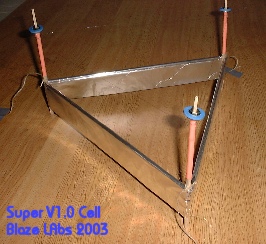
The high electric field intensity around the fine wire ionises the air
molecules, which are in turn repelled from the same wire and attracted
towards the bottom, negatively charged electrode. The forces involved are
given by Coulomb's Law. As each positive ion is attracted toward the
collector foil, it in turn attracts the collector toward it, pulling the
lifter up. At the same time, its repulsion from the top wire also pushes the
lifter upward. By Newton's laws, the momentum that the lifter gains in the
upward direction is equal to the net downward momentum of all the ions (conservation
of momentum). This is basically what happens if we do not consider any
reaction forces with neutral molecules. Now if this were all that happened,
when the ions collide with the lifter at the bottom electrode, (as they all
probably do), the momentums would cancel (add up to zero) and the lifter
would not move. Here is where the neutral air molecules come into play. As
the ions travel "downward" toward the bottom electrode, they collide with
neutral air molecules, transferring some of their downward momentum to the
neutral air, driving them generally downward.
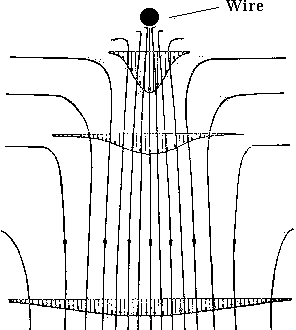
By conservation of momentum, the total momentum of the projected ion and the
target neutral air molecule before collision would be the same after
collision, but after the collision, the ion would have less downward
momentum. The ion has now transferred some downward momentum to a neutral
air molecule. After many similar collisions, the ion having speeded up and
crashed many times over its path to the collector, eventually hits the
collector foil, transferring any remaining or re-acquired downward momentum
against the upward momentum of the lifter. But the amount of downward
momentum it transfers is far less than the total amount of upward momentum
it provided the lifter during its travel downward. Most of that momentum has
now been transmitted to the neutral air molecules. The neutral air, since it
is not attracted to the lifter by electrostatic attraction, will just blow
by the sides of the lifter and can be detected as a neutral wind below it.
Most of these neutral molecules do not impact the collector and hence their
net thrust is not cancelled. If we add up all the downward momentum
components in the vertical direction of the neutral air and the ions in
flight, it will equal the "upward" momentum of the lifter. The lifter can
fly in the air, because the neutral air can take away some of the downward
momentum, leaving the lifter/ion combination with a net upward momentum. It
has all to do with momentum transfer between ions and neutral air molecules
and their flow profile, laminar or vortex flows being most efficient.
As shown in the diagram above, the fluid about the centre axis will reach a
velocity much higher than the rest of the fluid. If we where using a perfect
fluid with no viscosity only a very thin jet will be formed and propagate in
the direction of the collector. Because of the existence of viscosity, the
flow will slow down somehow in the direction of the collector and
simultaneously will became a bit larger, with the surrounding parts of the
flow being progressively carried by it.
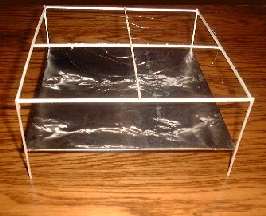
If we start to increase the size of the bottom electrodes (or more generally
the cross-sectional area of the lifter "presented" to the direction of
flight), whether it is electrically part of the collector or not, more and
more of the neutral air molecules will hit the lifter structure. If enough "neutral"
air is hitting and transferring momentum back onto the collector, the lifter
will be unable to fly. The Horizontal plane lifter shown above proves this
point with its zero thrust.
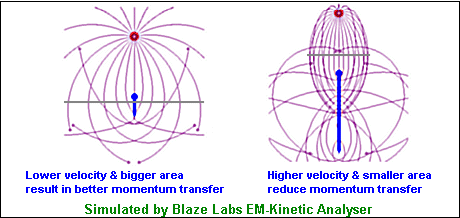
If we start to reduce the air pressure, i.e. taking away some of the neutral
air, the ions (which arestill being created to a lesser extent), can
transfer less and less momentum to the neutral air. There are less and less
air molecules to hit. Instead, they carry more and more momentum all the way
to the lifter collector, in a narrow vertical path, and transfer it when
they hit the upper edge of the foil. At some reduced pressure (nowhere near
a vacuum) not enough momentum gets transferred to the neutral air, it is all
getting transferred back to the lifter, and the lifter will fall. The ions
now are hitting it with enough momentum to cancel any upward momentum and
gravity will pull the lifter down. The vacuum experiments that have been
done confirm this.
At the time of writing, lifters do not seem to violate any known "conventional"
science. The main mechanism is just a transfer of momentum to the neutral
air, and if we do not have enough neutral air the lifter simply cannot fly.
The amount of force that can actually be generated by this process depends
on the accelerating voltage gradient, which accelerates the positive ions
between each impact, and the volume of neutral molecules, which get a
momentum exchange in the downward vertical direction. It is also understood
that the volume of neutral molecules effected will depend upon both EHD
thruster's size and shape as well as on the actual flow profile of the
neutral molecules. The main parameters involved are electrode shape and
size, and voltage, and parameters defining the neutral air molecules. Once
you work out the correct values, the EHD thruster may become autonomous,
with both payload and power supply on-board.
Lifters in hard vacuum
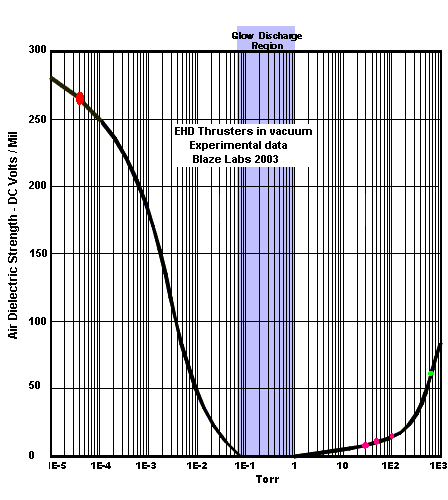
Curve showing air dielectric strength vs air pressure.
At a glance, this curve explains why lifters do not work in the pressure
region shown as glow discharge area, since the airgap virtually represents a
short circuit. It also explains the fact why lifters work better at sea
levels (760 Torr) than at very high altitude levels. Atmospheric pressure is
much lower at high altitudes.
Referring to the curve shown above:
The green point is at 760 Torr (STP), tested as the normal atmospheric
pressure at which EHD thrusters lift.
The 3 purple points give a lot of air ionisation with much reduced thrust.
The blue band, shows the glow discharge region, where ionisation and spark-overs
are the main results, with zero thrust.
Below is a photo of the lifter operating at 4E-2 Torr, just under the glow
discharge area, with lots of glow discharge and no thrust.
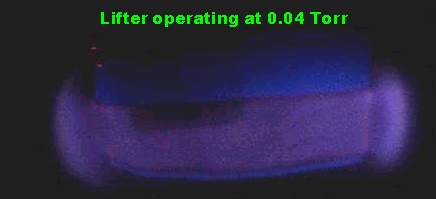
Pressures above the green point give better lift and less chance of
ionisation. The big question, which will totally disprove any other theory (especially
antigravity), is whether or not the EHD thruster works at much lower
pressures, where the air dielectric strength recovers again to its STP (760
Torr) value, which is approximately from 6E-3 Torr down. For this purpose an
experiment in high vacuum has been set up as shown below:
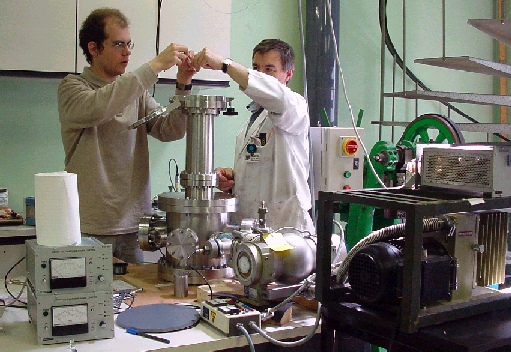
The following equipment is used in the setup shown above:
PFEIFFER oil pump type AMEB 80FY4R3N1, 0.55 kW /1400 rpm, combined (serial)
with a
PFEIFFER type TPH 330, pumping speed 330 l/s
Cylindrical vacuum chamber, height 24 cm, diameter 24 cm
Pressure detectors: PIRANI-cold cathode gauge control, Balzers 1KR020,
TRR010 and RKG020.
The lowest pressure that the system can achieve is of 6E-6 mbar.
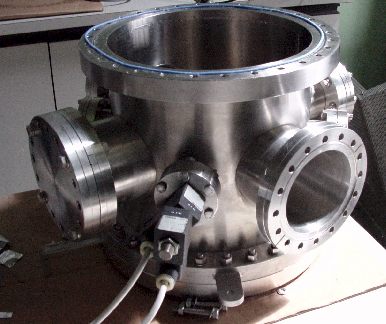
Close up view of the cylindrical vacuum chamber used during the test
During this experiment, the lifter in the chamber was not flying but was set
hanging down on a very weak spring. The position of the lifter could be
easily observed from the exterior. As the pressure was diminished below 8 to
15 Torr, thrust was no longer observed. The pressure was then diminished
further to go far below the glow discharge area into the hard vacuum region.
Air was pumped out to a pressure of 3.75E-5 Torr,
indicated by the big red dot on the dielectric strength plot shown above. At
this pressure, the 30 kV potential across the lifter element can easily be
handled and no arcing or glow discharge occurs. The result of this
experiment was zero thrust, or at least no thrust that could change the
position of our very weakly spring loaded lifter. This definitely confirms
that the main lifters' thrust is of an ElectroHydroDynamic form, due to ion
interaction with neutral air particles, and disproves once for all any
antigravity theory.
I would like to thank Willy Oscar Guns for making this experiment possible,
and for all other members at Blaze Labs Research group, in particular to
Rolland Swank, for their contributions to this page.
Ana Sayfa ·
İndex·
Ziyaretçi
Defteri
![]() E-Mail
Roket bilimi
E-Mail
Roket bilimi
Time Travel Technology UFO Technology Kuantum Fiziği Kuantum Teleportation